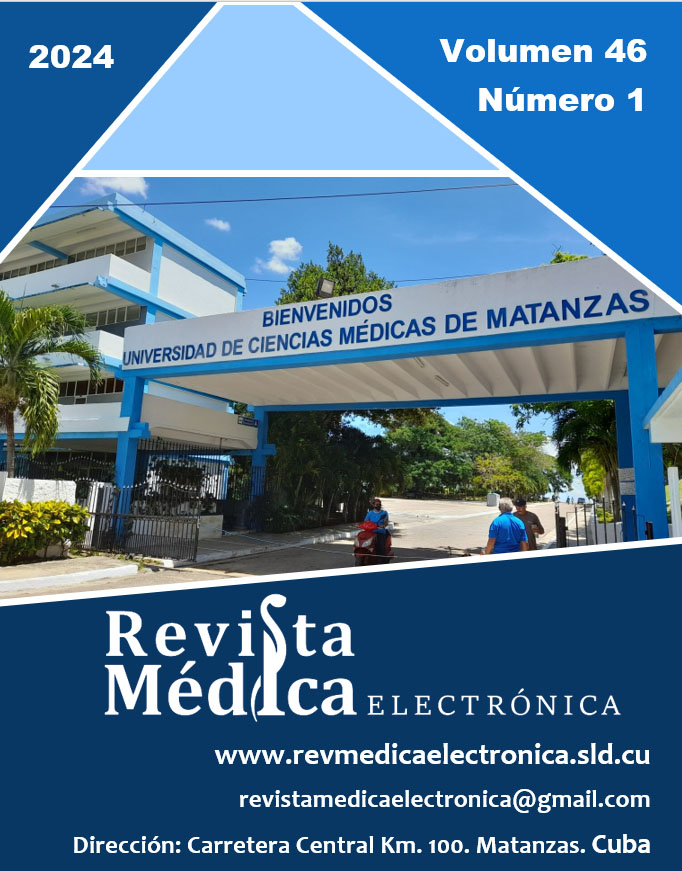Acupuncture in the induction of labor in full-term pregnant women without associated pathology
Keywords:
induction of labor, acupunctureAbstract
Introduction: In recent years, in several gyneco-obstetric hospitals throughout the country, the effect of acupuncture in stimulating labor in pregnant women at term has been evidenced.
Objective: To evaluate the effectiveness of acupuncture in the induction of labor in term pregnant women without associated pathology.
Method: Cross-sectional descriptive observational study, in the period January 2018 to January 2020, of full-term pregnant women without associated pathology to whom the acupuncture method was applied for the induction of labor at the Provincial Gyneco-obstetric Teaching Hospital José Ramón López Tabrane, from Matanzas.
Results: A higher frequency of patients in the age group of 20-24 years, primiparas, who required an acupuncture session, with contractile response in the period of up to 12 hours; labor of up to six hours, eutocic delivery and without induction was identified; with oxytocin; in some age groups, the risk of adverse events, instrumental delivery and perinatal asphyxia was increased; contractile response in 21-36 hours increased the risk of cesarean section, induction, bleeding and maternal sepsis.
Conclusions: The results of the application of acupuncture are satisfactory; the contractile response variable should be followed up in the period of 21-36 hours; it is necessary to continue delving into the research topic.
Downloads
References
2. Gary Cunningham F, Leveno KJ, Bloom SL, et al. Williams. Obstetricia. Cap. 26. Inducción y aumento del trabajo de parto [Online]. 25ª ed. España: Mc Graw-Hill Interamericana, S.A.; 2019 [cited 2023/11/17]. p. 503-14. Available from: https://accessmedicina.mhmedical.com/content.aspx?bookid=1525§ionid=100459628
3. Anaya Herazo CA, Aguilar Estrada JA. Caracterización de gestantes que recibieron inducción del trabajo de parto con oxitocina. Hospital Ramón González Coro. 2022-2023 [Online]. La Habana: XVIII Congreso de la Sociedad Cubana de Ginecología y Obstetricia; 2023 [cited 2023/11/17]. Available from: https://ginecobs2023.sld.cu/index.php/ginecobs/2023/paper/viewFile/155/92
4. Gil Rouquier N, Jiménez Siles S. Acupuntura como inducción del trabajo de parto. Biblioteca Lascasas [Online]. 2022 [cited 2023/11/17]; 18:e13414. Available from: https://ciberindex.com/c/lc/e13414
5. Briones-Rivas NA, Baus-García CA, Flores-Vega JL, et al. Sufrimiento fetal asociado al uso de oxitocina en la inducción del trabajo de parto en embarazos de término. Pol Con [Online]. 2022 [cited 2023/11/17];7(5):612-31. Available from: https://dialnet.unirioja.es/descarga/articulo/9042701.pdf
6. Dada J, Ronzoni S. Sex for Induction of Labor. In: Dan Farine, Tobías González P. Sex and Pregnancy: From Evidence-Based Medicine to Dr Google [Online]. Cambridge: Cambridge University Press; 2022 [cited 2023/11/17]. p. 165-72. Available from: https://www.cambridge.org/core/books/abs/sex-and-pregnancy/sex-for-induction-of-labor/197F1CF1EF269FB3A6F51FEF69E0BC5C
7. Jackson C, Bailey J. Potential Benefits of Acupuncture for Hypertensive Disorders in Pregnancy: A Case Series. ConvergPts [Online]. 2022 [cited 2023/11/17];1(2). Available from: https://www.convergentpoints.com/article/view/16
8. Lowe LA, Betts D. Midwifery Acupuncturists' Management of Antenatal Anxiety and Depression: Data from a Survey in DOI: 10.1089/acu.2022.0062.
9. Jackson HJ, Reneau MG, Hande K. A Scoping Review of Measures Utilized to Assess Patient Satisfaction with Acupuncture Treatments Within Randomized Controlled Trials. Med Acupunct. 2022;34(5):308-15. DOI: 10.1089/acu.2022.0015.
10. Kumar N, Singh Yadav A, Verma A. Acupressure Therapy in Pregnancy. Ind J Nur Sci [Online]. 2023 [cited 2023/11/16];8(3):42-7. Available from: https://innovationaljournals.com/index.php/ijns/article/view/440
11. Rukmindar D, Pekerti F, Sirvel R, et al. The Role of Self-Care Acupressure in Maternal Health Problems to Support the Sustainable Development Goals Program in the Health Sector: A Narrative Review. Med Acupunct [Online]. 2023 [cited 2023/11/16];35(4):170-9. Available from: https://pubmed.ncbi.nlm.nih.gov/37609550/
12. Molina Guerra C. Estimulación del trabajo de parto con el método acupuntural en gestantes a término. Hospital Docente Ginecobstetrico Provincial “Dr. Julio Rafael Alfonso Medina” [thesis]. Matanzas: Universidad de Ciencias Médicas de Matanzas; 1995.
13. Espinoza A. El método acupuntural en la estimulación del parto y la madurez cervical. Hospital Docente Ginecobstétrico Provincial “Dr. Julio Rafael Alfonso Medina” de Matanzas [thesis]. Matanzas: Universidad de Ciencias Médicas de Matanzas; 2012.
14. Suárez Y. Estimulación del trabajo de parto con acupuntura en pacientes con Diabetes Mellitus Gestacional, Hospital Docente Ginecobstétrico Provincial “Dr. Julio Rafael Alfonso Medina” [thesis]. Matanzas: Universidad de Ciencias Médicas de Matanzas; 2014.
15. Martell Rodríguez A. Acupuntura en inducción del parto en gestantes a término con rotura prematura de membranas. Hospital Docente Ginecobstétrico Provincial “Dr. Julio Rafael Alfonso Medina” [thesis]. Matanzas: Universidad de Ciencias Médicas de Matanzas; 2016.
16. Wheeler V, Ariel H, Michael B. Cervical ripening and induction of labor. Am Fam Physician [Online]. 2022 [cited 2023/11/16];105(2):177-86. Available from: https://www.aafp.org/pubs/afp/issues/2022/0200/p177.html
17. Lopes GA, Teixeira TT, Leister N, et al. Methods of induction and augmentation of labor in a freestanding birth center: a cross-sectional study. Rev Esc Enferm USP. 2023;57:e20230158. DOI: 10.1590/1980-220X-REEUSP-2023-0158en.
18. Álvarez Tudela CR, Carrasco Russ BP, Sánchez Concha FI, et al. Efectividad de métodos naturales para inducir el trabajo de parto: revisión bibliográfica mundial, 2012-2021 [thesis Online]. Bellavista: Universidad San Sebastián; 2022 [cited 2023/11/16]. Available from: https://repositorio.uss.cl/handle/uss/8529
19. Miramon A. Effectiveness of Acupuncture for Induction of Labor: A Literature Review. JASA [Online]. 2020 [cited 2023/11/16];7(3). Available from: https://openurl.ebsco.com/EPDB%3Agcd%3A2%3A28807474/detailv2?sid=ebsco%3Aplink%3Ascholar&id=ebsco%3Agcd%3A146068514&crl=c
20. Schlaeger JM, Gabzdyl EM, Bussell JL, et al. Acupuncture and Acupressure in Labor. J Midwifery Womens Health [Online]. 2017 [cited 2021/04/02];62(1):12-28. Available from: https://pubmed.ncbi.nlm.nih.gov/28002621/
21. Neri I, Pignatti L, Fontanesi F, et al. Acupuncture in Postdate Pregnancy Management. J Acupunct Meridian Stud [Online]. 2018 [cited 2021/04/21];11(5):332-6. Available from: https://pubmed.ncbi.nlm.nih.gov/29890286/
22. Amir N, Berger R, Grinfeld T, et al. Efficacy comparison between Chinese medicine's labor inducement methods and conventional methods customary in hospitals. Harefuah [Online]. 2015 [cited 2021/04/21];154(1):47-51. Available from: https://pubmed.ncbi.nlm.nih.gov/25796676/
23. Hernández Cabrera Y, Ruiz Hernández M. Preinducción del parto con misoprostol. Una opción útil en la maduración cervical anteparto. Medisur [Online]. 2017 [cited 2021/05/05];15(2):165-7. Available from: http://www.medisur.sld.cu/index.php/medisur/article/view/3460
Downloads
Published
How to Cite
Issue
Section
License
All content published in this journal is Open Access, distributed under the terms of the CC BY-NC 4.0 License.
It allows:
- Copy and redistribute published material in any medium or format.
- Adapt the content.
This will be done under the following terms:
- Attribute the authors' credits and indicate whether changes were made, in which case it must be in a reasonable way.
- Non-commercial use.
- Recognize the journal where it is published.
The copyrights of each article are maintained, without restrictions.






